- More to Explore
- Series & Movies
Published Dec 7, 2023

Looking Back at the Music of 'Star Trek: The Motion Picture'
How Jerry Goldsmith tackled the majestic score for the Enterprise's first big screen adventure, in theaters 44 years ago today.
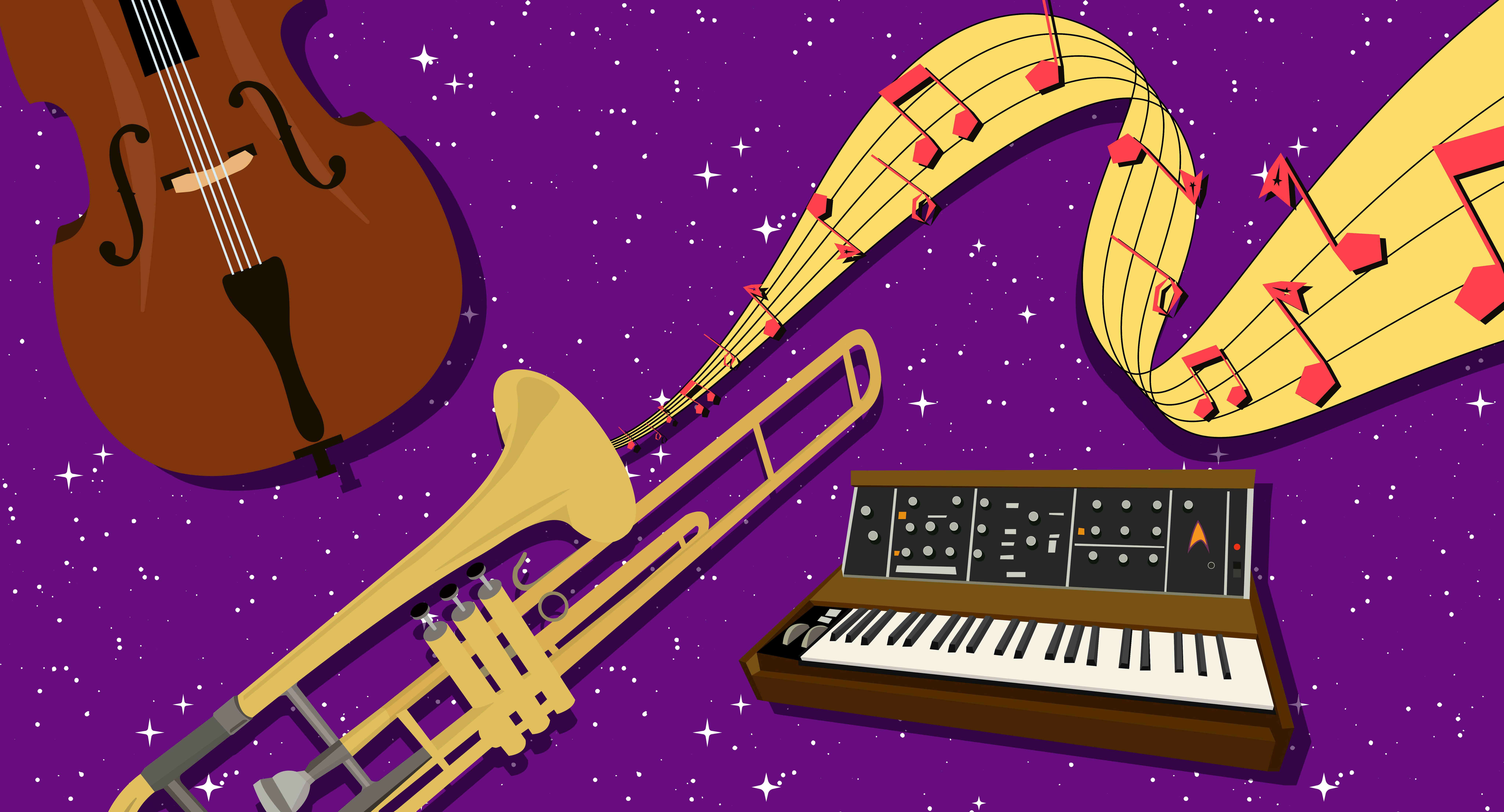
StarTrek.com / Charlotte Tegen
"I was miserable," admitted Jerry Goldsmith.
Four months from the December 7, 1979 release date of Star Trek: The Motion Picture , the composer only had a limited amount of footage and had to begin recording in a month. It was hardly an ideal situation, and it would get worse before it got better, but Goldsmith's score would go on to become an iconic part of Gene Roddenberry's creation.
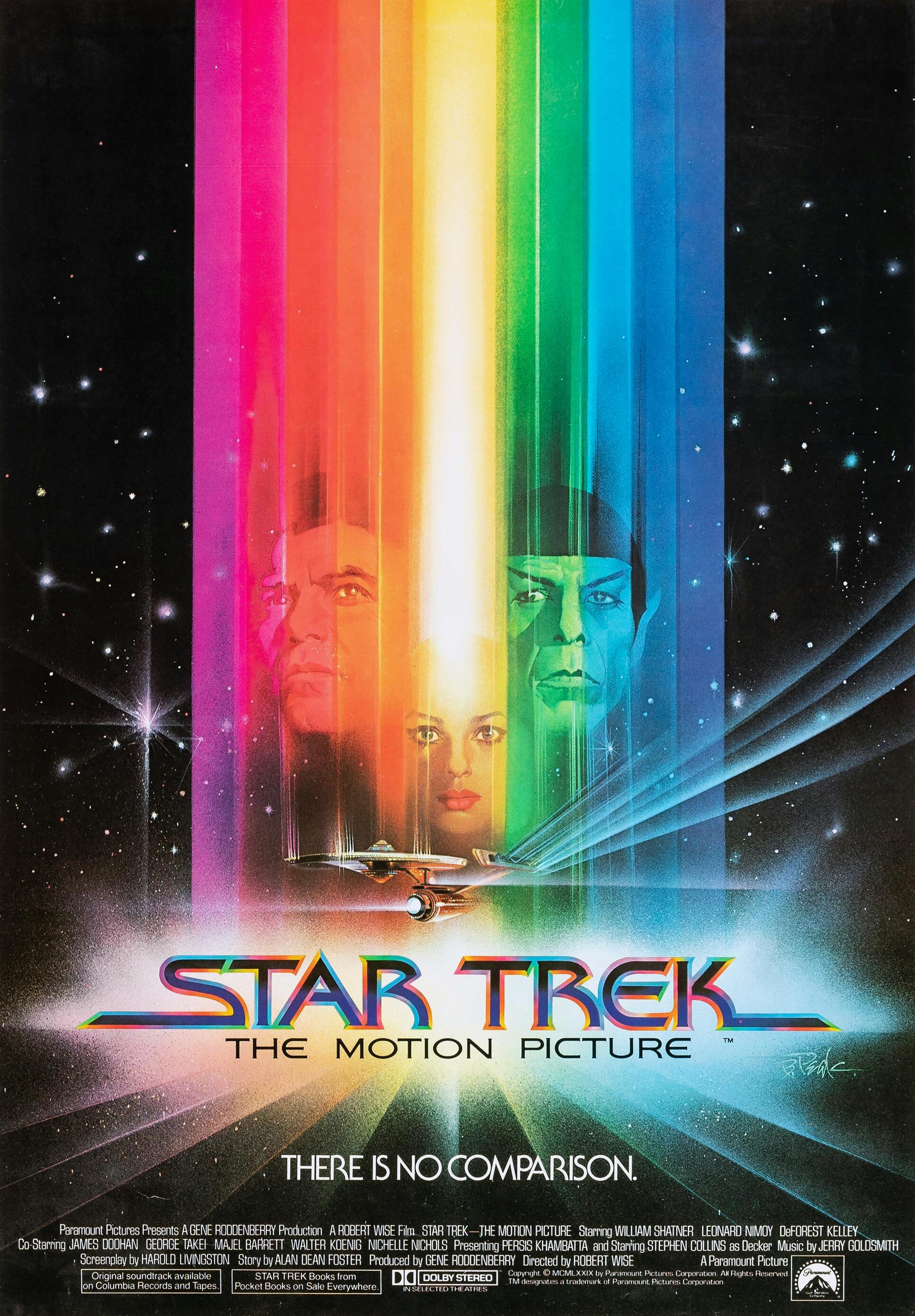
StarTrek.com
The issues during The Motion Picture ’s production were far larger than the music. Paramount had given the film a budget of $46M and locked in the release date while there were still story problems, not to mention visual effects difficulties. Subsequently, the post-production process was manic, and Goldsmith was writing music as fast as he could with what little he had. But when he put his music in front of the orchestra to record, director Robert Wise was less than thrilled.
Recalling his thoughts on the 2001 DVD release of the Director’s Edition of the film, Wise said, "It's not working. I listened to the first couple of pieces and it didn't seem quite right to me. I got visions of sailing ships somehow.."
In the same behind-the-scenes interview, Goldsmith admitted, "I was crushed." Wise went onto explain his problem with the music — there was no theme. Specifically, there was no Star Trek theme.
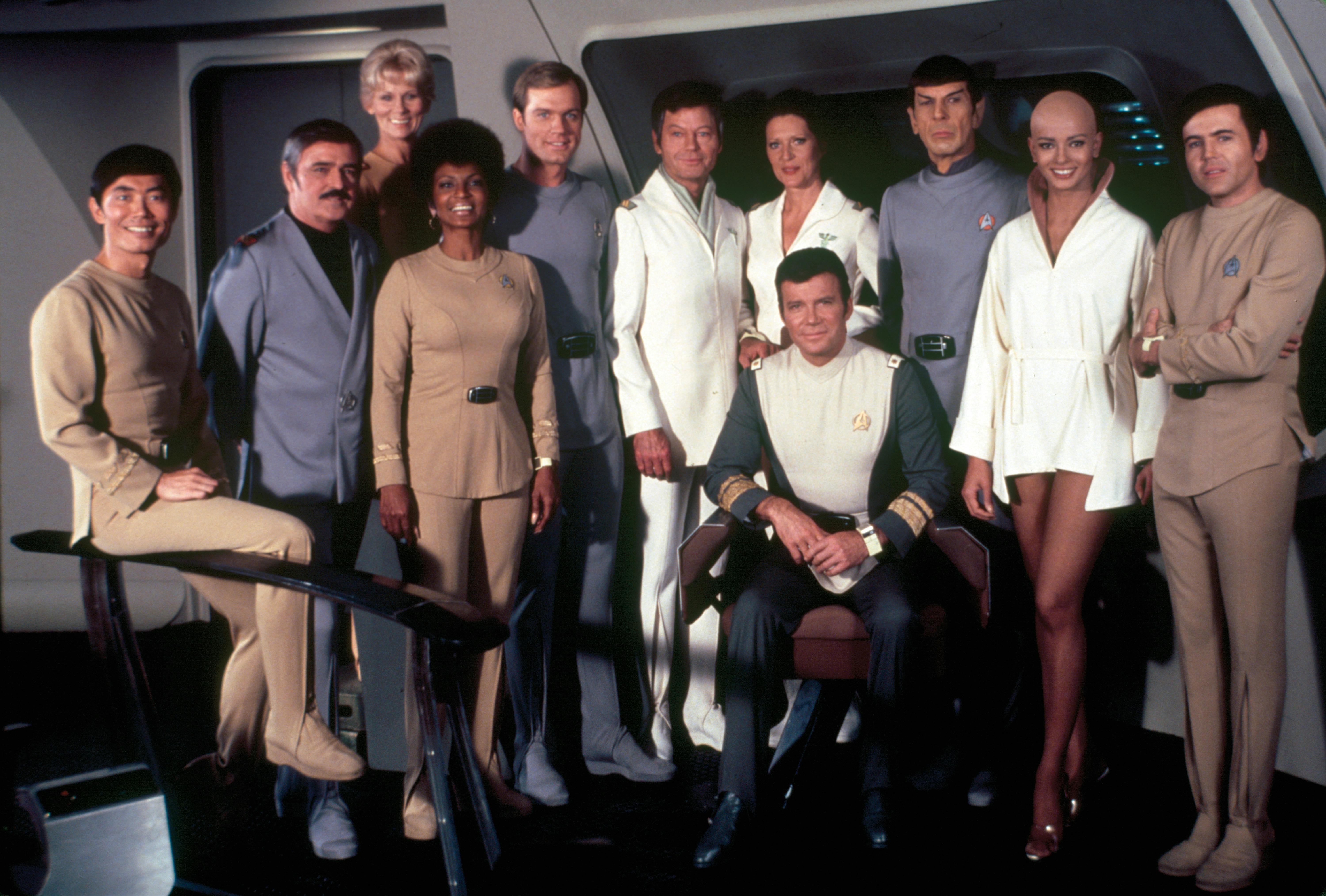
The composer struggled on, but 10 days later, he played his new creation for the director. Upon hearing the next version, Wise approved and asked, "Why didn't you come up with that in the first place?" With the themes written, Goldsmith revised the cues he had previously recorded, and the score was on its way.
Goldsmith recruited original Star Trek composer Fred Steiner to write several cues based on the material, and November of 1979 saw the belated arrival of some of the film's effects sequences. The score was finally completed on December 2, and five days later, The Motion Picture left drydock.
While reviews were mixed across the board, Goldsmith's score stood out as a towering achievement, one that not only gained him his 12th Oscar nomination (he had previously won for 1976's The Omen ), but also one that would be an integral part of Star Trek' s future legacy.

One of the challenges Goldsmith faced was to compose a symphonic score that was different from John Williams' Star Wars compositions, which hit two years prior. Instead of the leitmotif device Williams utilized, Goldsmith employed his main theme as a backbone, using it to encapsulate an approach that combined the romance and mystery of space exploration. This was a new direction for Goldsmith, venturing into a more romantic idiom of scoring.
"He was definitely a modernist," said composer David Newman in the liner notes for La-La Land’s definitive release of the soundtrack. Newman, who played the violin on The Motion Picture , added, "I think Star Trek was a turning point for him. I think he realized he couldn't be a Planet of the Apes modernist and compose [for] films."
But The Motion Picture is still very much a Jerry Goldsmith score, especially in the way it adds esoteric instruments and electronic augmentation to the traditional orchestra, harking back to previous scores such as Planet of the Apes (1968) and Alien (1979). One of the signature sounds of the film is the blaster beam, the instrument which emits the harsh electronic tones for V'Ger . This was built and performed by Craig Huxley, using "a long piece of aluminum with metal strings strung the whole way over it and amplifiers under each string," as Goldsmith described it.
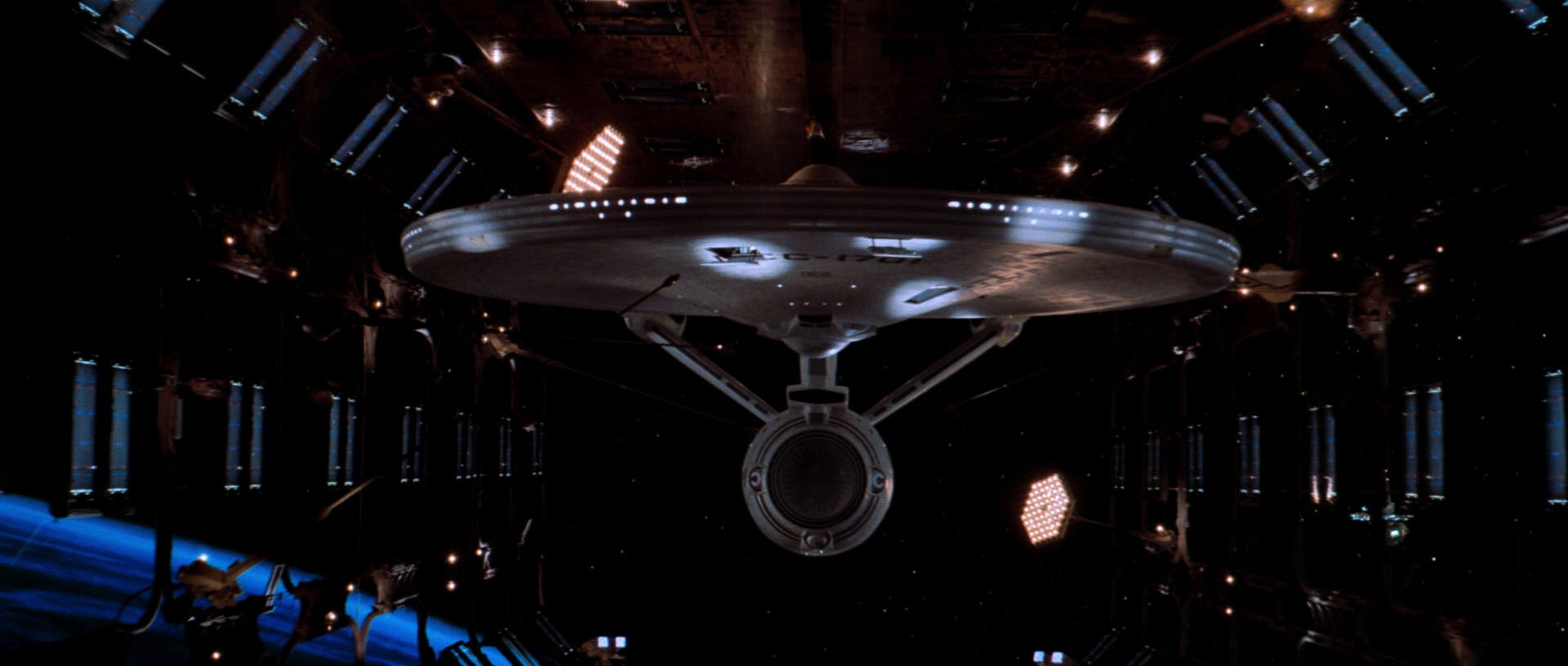
Star Trek: The Motion Picture
Goldsmith introduces his main theme in a thundering fashion, setting out his intent in the opening credits, which, in the La-La Land liner notes, film score expert Jeff Bond calls "a musical distillation of Roddenberry's utopian vision." In the same notes, Goldsmith himself echoed Roddenberry's original concept of Star Trek as a western, saying that it was no different than "the stirring music you'd play in a western as they're going across the plains... The only difference is you're going across the universe."
Goldsmith's theme conjures up a bold feeling of exploration, cutting a path through the stars with the Enterprise in its wake, while its B-theme suggests not only adventure but the connection between Admiral Kirk and the starship herself. Goldsmith expanded on this in "The Enterprise ," the show-stopping cue that scores the moment when Kirk and the audience first glimpse the brand-new refitted starship.

Almost as a contrast to the Federation's benign mission, the opening sequence introduced Goldsmith's theme for the legendary warrior race of Klingons. Setting a trend for other composers to follow, Goldsmith used the theme to summarize their barbaric and aggressive tendencies, with the Indonesian angklung and plucked strings leading the sharp and angled main melody. Interestingly, Goldsmith would return to this material for his score to Star Trek: First Contact , where it was turned on its head to become a heroic motif for the character of Worf.
Goldsmith's music for V'Ger explores the dynamics between the idea of a living machine — a contradiction in terms — and its quest to meet its creator, with a long-lined undulating melody conveying a mechanical feel but also suggesting that something else lies under the surface. The score also features a haunting ostinato for the Enterprise 's journey through V'Ger , and surprisingly, another motive, which is a minor-mode version of Ilia's theme, foreshadowing the union at the climax of the film.
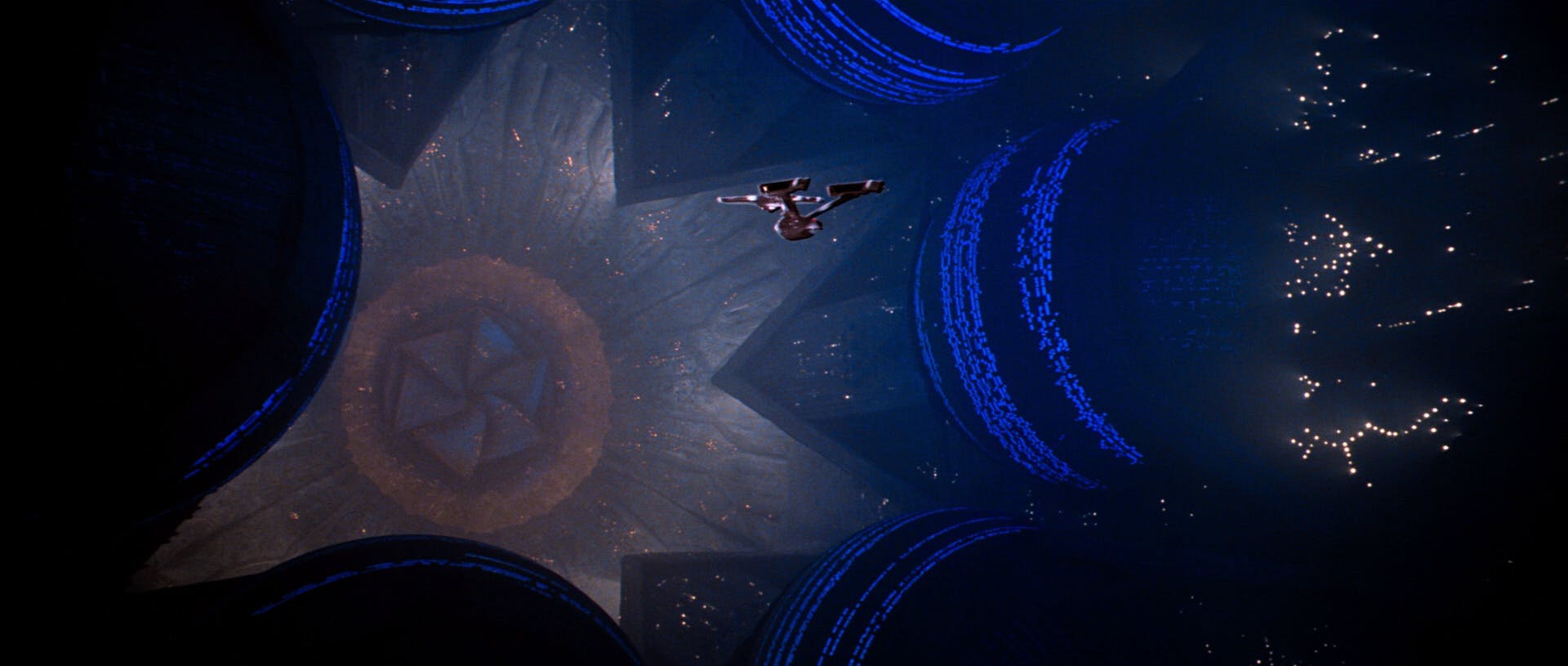
Ilia's theme, which also appears as the overture —one of the last for a theatrical film for several decades — is the main love theme of the film, a gorgeous but delicate melody representing the Deltan's previous relationship with Commander Decker. Also in tune with V'Ger is the composer's fascinating theme for Spock, a truly alien melody that captures the character's unemotional state as he unsuccessfully attempts to purge his human emotions in the Kolinahr ritual, which Goldsmith juxtaposes with the V'Ger material to indicate their destinies may be intertwined.
An interesting anomaly is the lack of music referring to The Original Series . While Star Trek as a franchise is still musically defined by Alexander Courage's famous opening fanfare, Goldsmith requested to not use any of Courage's music. Although, he later relented and allowed Courage to write an arrangement of his main theme to score two sequences where Kirk narrates the Captain's Log. The result is a pair of brief cues that present the theme in a very subdued manner, a far cry from its use in the original series but appropriate for the seriousness of the Enterprise 's mission.
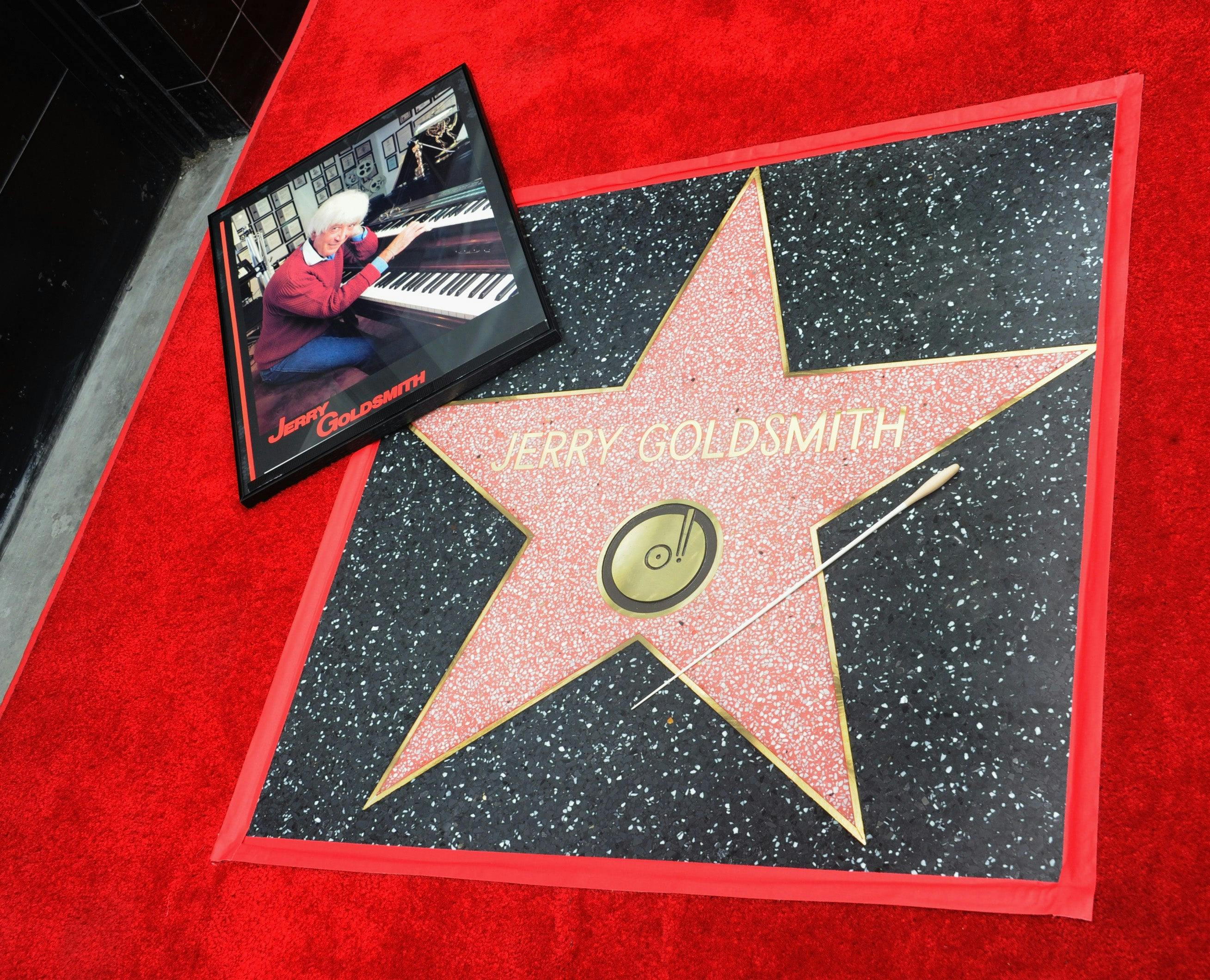
Getty Images
Jerry Goldsmith returned to the franchise in 1987 when The Next Generation debuted, with the opening credits of the show successfully combining the Courage fanfare and the Goldsmith theme (something the composer would later do himself in 1989 for Star Trek V: The Final Frontier ). He composed music for three additional movies, as well as wrote the main title theme for Star Trek: Voyager . Whether it was for film or television, where Star Trek was concerned, Goldsmith was omnipresent.
Sadly, Jerry Goldsmith passed in 2004. However, his music for Star Trek and particularly The Motion Picture continues to live on, through the wonderful La-La Land soundtrack release, as a concert staple, and in the hearts of Star Trek fans across the universe. For them, there is no comparison.
Star Trek: The Motion Picture (soundtrack)
- View history
Overview [ ]
The first and one of the most influential Star Trek film scores, Jerry Goldsmith 's introduction to the Star Trek universe is by many considered to be one of the composer's finest works - an effort acknowledged by an Academy Award nomination in 1979.
Goldsmith's The Motion Picture takes the now standard sweeping orchestral fanfares and twists them into deep science fiction compositions, comparable to his own experimental stylings for the original Planet of the Apes . The key element to this infusion of style, bordering on bizarre, is the utilization of the "Blaster Beam" - a large, metallic instrument, heard first during the Klingon battle and underscoring V'Ger and its mechanical nature.
More traditional, Williams-esque orchestrations, however, are the primary thrust of The Motion Picture , with beautiful and energetic compositions representing the Enterprise (later used in the titles for Star Trek: The Next Generation and four more films), the Klingons (later utilized as Worf 's theme in Star Trek: First Contact and beyond), and Ilia – the love theme that opens the film. Clearly the most dynamic and memorable Enterprise theme opening and closing the film, and going on to far surpass Alexander Courage's original Star Trek theme as the sound of the franchise. First criticized by director Robert Wise as being far too "nautical" – a motif laid heavily into the sound of James Horner 's contributions for II and III – Goldsmith's theme went through several iterations before the now-famous march took shape.
While many elements of this the first Trek film outing would come to be reviled by fans and producers alike, Goldsmith's contribution endures despite the infusion of four more composers over the course of nine more features. Goldsmith himself would return to score Star Trek V and the latter three TNG films, introducing new themes and motifs to the fold, but always staying true to and expanding upon the groundwork laid here.
Track listing [ ]
See also [ ].
- Star Trek: The Motion Picture - 20th Anniversary Collector's Edition
- Star Trek: The Motion Picture (expanded soundtrack)
- 3 Ancient humanoid
![star trek 1979 theme Star Trek: The Motion Picture [Music from the Original Soundtrack]](https://fastly-s3.allmusic.com/release-covers/400/0000/282/0000282242.jpg)
Star Trek: The Motion Picture [Music from the Original Soundtrack]
Jerry goldsmith.
STREAM OR BUY:
Release Date
Recording date, recording location, discography timeline, allmusic review, user reviews, track listing, similar albums, moods and themes.
Movie Reviews
Tv/streaming, collections, great movies, chaz's journal, contributors, star trek: the motion picture.

Now streaming on:
Epic science-fiction stories, with their cosmic themes and fast truths about the nature of mankind, somehow work best when the actors are unknown to us. The presence of the Star Trek characters and actors who have become so familiar to us on television tends in a strange way to undermine this movie. The audience walks in with a possessive, even patronizing attitude toward Kirk and Spock and Bones, and that interferes with the creation of the "sense of wonder" that science fiction is all about.
Let's begin with the toy for the eyes. The Star Trek movie is fairly predictable in its plot. We more or less expected that two of the frequent ingredients in the television episodes would be here, and they are: a confrontation between Starship Enterprise and some sort of alien entity, and a conclusion in which basic human values are affirmed in a hostile universe. In "Star Trek: The Motion Picture", the alien entity is an unimaginably vast alien spaceship from somewhere out at the edge of the galaxy. The movie opens as it's discovered racing directly toward Earth, and it seems to be hostile. Where has it come from, and what does it want?
The Starship Enterprise, elaborately rebuilt, is assigned to go out to intercept it, with Admiral Kirk, of course, in charge. And scenes dealing with the Enterprise and the other ship will make up most of the movie if the special effects aren't good, the movie's not going to work. But they are good, as, indeed, they should be: The first special-effects team on this movie was fired, and the film's release was delayed a year while these new effects were devised and photographed. (The effects get better, by the way, as the movie progresses. The alien ship looks great but the spaceports and futuristic cities near the film's beginning loom fairly phony.)
The Enterprise, perhaps deliberately, looks a lot like other spaceships we've seen in " 2001: A Space Odyssey ," " Silent Running ," "Star Wars," and " Alien ." Kubrick's space odyssey set a visual style for the genre that still seems to be serviceable. But the look of the other spaceship in " Star Trek " is more awesome and original. It seems to reach indefinitely in all directions, the Enterprise is a mere speck inside of it, and the contents of the alien vessel include images of the stars and planets it has passed en route, as well as enormous rooms or spaces that seem to be states of a computer-mind. This is terrific stuff.
But now we get to the human level (or the half-human level, in the case of Mr. Spock). The characters in this movie are part of our cultural folklore; the Star Trek television episodes have been rerun time and time again. Trekkies may be unhappy with me for saying this, but there are ways in which our familiarity with the series works against the effectiveness of this movie. On the one hand we have incomprehensible alien forces and a plot that reaches out to the edge of the galaxy.
On the other hand, confronting these vast forces, we have television pop heroes. It's great to enjoy the in-jokes involving the relationships of the Enterprise crew members and it's great that Trekkies can pick up references meant for them, but the extreme familiarity of the Star Trek characters somehow tends to break the illusion in the big scenes involving the alien ship.
Such reservations aside, "Star Trek: The Motion Picture" is probably about as good as we could have expected. It lacks the dazzling brilliance and originality of 2001 (which was an extraordinary one-of-a-kind film). But on its own terms it's a very well-made piece of work, with an interesting premise. The alien spaceship turns out to come from a mechanical or computer civilization, one produced by artificial intelligence and yet poignantly "human" in the sense that it has come all this way to seek out the secrets of its own origins, as we might.
There is, I suspect, a sense in which you can be too sophisticated for your own good when you see a movie like this. Some of the early reviews seemed pretty blase, as if the critics didn't allow themselves to relish the film before racing out to pigeonhole it. My inclination, as I slid down in my seat and the stereo sound surrounded me, was to relax and let the movie give me a good time. I did and it did.

Roger Ebert
Roger Ebert was the film critic of the Chicago Sun-Times from 1967 until his death in 2013. In 1975, he won the Pulitzer Prize for distinguished criticism.
Now playing

You Can Call Me Bill
Clint worthington.

In the Land of Saints and Sinners
Brian tallerico.

Christy Lemire

Kaiya Shunyata

Dad & Step-Dad
Carlos aguilar.

The Animal Kingdom
Monica castillo, film credits.

Star Trek: The Motion Picture (1979)
132 minutes
William Shatner as Kirk
Leonard Nimoy as Spock
James Doohan as Scotty
George Takei as Sulu
Walter Koenig as Chekov
Directed by
- Robert Wise
Screenplay by
- Harold Livingston
Produced by
- Gene Roddenberry
Latest blog posts

Until It’s Too Late: Bertrand Bonello on The Beast

O.J. Simpson Dies: The Rise & Fall of A Superstar

Which Cannes Film Will Win the Palme d’Or? Let’s Rank Their Chances

Second Sight Drops 4K Releases for Excellent Films by Brandon Cronenberg, Jeremy Saulnier, and Alexandre Aja

- April 12, 2024 | Interview: Wilson Cruz On How “Jinaal” Sets Up The Rest Of The Season For Culber On ‘Star Trek: Discovery’
- April 12, 2024 | ‘Star Trek: Strange New Worlds’ Renewed For Season 4; ‘Lower Decks’ To End With Season 5
- April 12, 2024 | Podcast: All Access Goes To Trill With ‘Star Trek: Discovery’ For “Jinaal”
- April 11, 2024 | Paramount Pictures Officially Confirms Star Trek Origin Movie For Its Upcoming Film Slate
- April 11, 2024 | Recap/Review: ‘Star Trek: Discovery’ Tries Too Many Connections In “Jinaal”
Jerry Goldsmith’s Full Orchestral Score For ‘Star Trek: The Motion Picture’ Published As Book For First Time
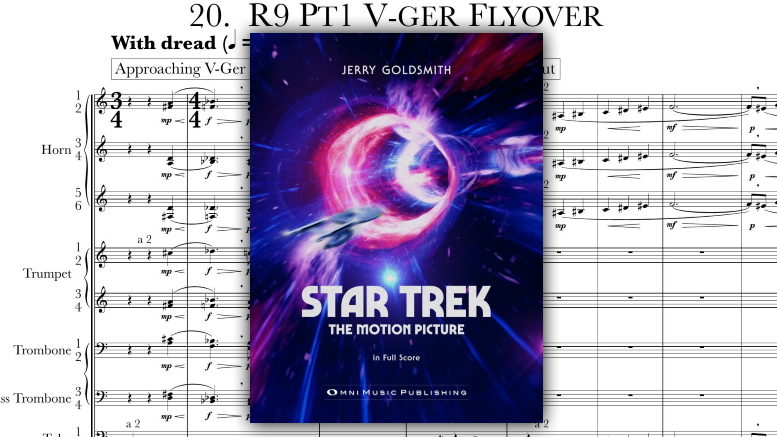
| April 14, 2021 | By: Lukas Kendall 12 comments so far
Fans of composer Jerry Goldsmith and Star Trek music now have a new way to celebrate his Oscar-nominated score for Star Trek: The Motion Picture .
Omni Music Publishes Star Trek: The Motion Picture Score Book
Now that dozens of Star Trek soundtrack albums have been released by the specialty CD labels as expanded collector’s editions, Omni Music is opening a new frontier by publishing Jerry Goldsmith’s legendary score to Star Trek: The Motion Picture as a bound book. This is the first full, complete orchestral score released for any Star Trek music from film or television.
This unique book features the written, full orchestrations to Goldsmith’s magnificent score for the first Star Trek feature film. The orchestrations are intended for large symphony orchestra (enhanced by specialty instruments) so this isn’t something you could easily use to play the music at home on your keyboard; in fact, the book is licensed for study only, and not performance. The full printed score corresponds to the 3-CD set of The Motion Picture soundtrack album released by La-La Land Records in 2012 .
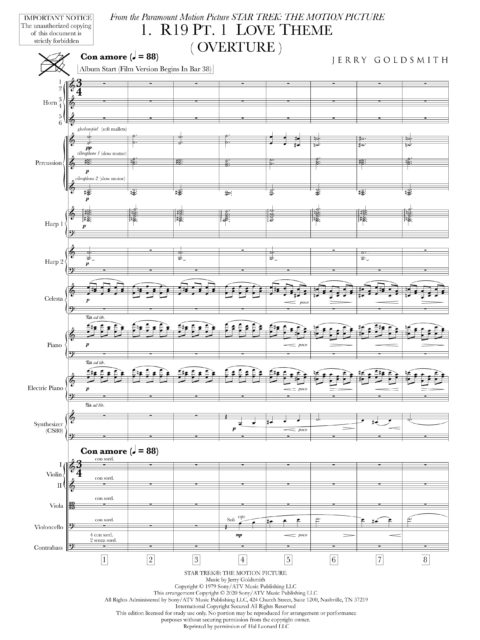
Sample page from Star Trek: The Motion Picture score book (Omni Publishing)
Omni Music Publishing is a specialty book company dedicated to publishing film scores in full, unabridged editions for fans, scholars, and music aficionados. While publishing classical music is pretty straightforward, doing the same for film scores is much more complicated due to dealing with the rights. There is also the archaeology work of locating the handwritten (and often, quite messy) original scores in studio vaults and engraving them (via computer) so that they are clear and legible. Omni has sorted through the red tape and undertaken the painstaking work to bring these treasures officially to the public.
Jerry Goldsmith’s score to Star Trek: The Motion Picture became the signature piece of Star Trek film music, with a main theme repurposed for Star Trek: The Next Generation (at Gene Roddenberry’s request) and also used by Goldsmith himself in his sequel scores for Star Trek V: The Final Frontier , First Contact , Insurrection, and Nemesis . It features a beautiful love theme (“Ilia’s Theme”) and magnificent, ominous passages for the alien V’Ger threat, enhanced by pipe organ and a unique instrument called the blaster beam. The score overflows with melody and orchestral invention.
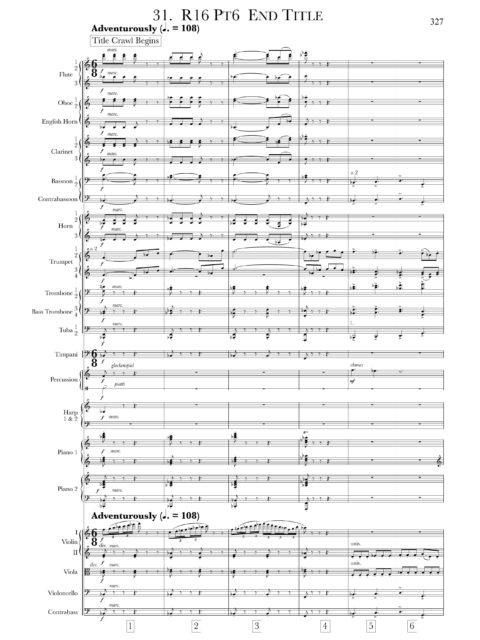
Because of the film’s troubled postproduction, Goldsmith wrote and recorded a number of alternate cues which were never heard until being presented on La-La Land’s 3CD set. All of them are included in a supplemental section of this book—along with four additional selections which Goldsmith wrote and had orchestrated, but which were never recorded in 1979, for one reason or another.
And the score all comes together in a beautiful 473-page, 9” x 12” bound softcover book. If you can’t read music, this will admittedly be like browsing a book published in a foreign language—but could still a beautiful collectible, with new cover art by Scott Saslow. The Star Trek: The Motion Picture score book can be purchased directly from Omni for $85.00 .
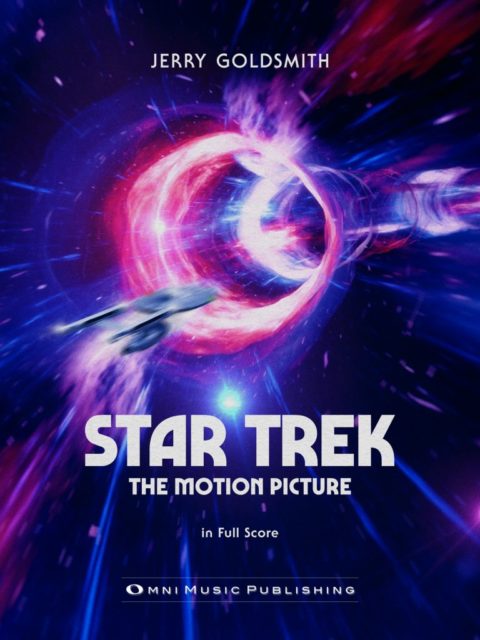
Visit Omni Music Publishing’s website to order and see other books in their catalog, such as The Matrix (Don Davis), Batman (Danny Elfman), Glory (James Horner) and Ghostbusters (Elmer Bernstein).
And if you are a musician looking for Star Trek sheet music to play at home with piano or other instruments, you can find a selection at musicnotes.com .
Bonus: TMP scene with unused “Body Meld” music
As a special treat for TrekMovie readers, composer Joe Kraemer ( Mission: Impossible—Rogue Nation , Jack Reacher ) has created a synthesized “mockup” of one of the unrecorded cues, Goldsmith’s original intended version of the climactic “Body Meld” (available in the new printed full score). Judge for yourself if Robert Wise was right to reject it for being “too romantic.”
Lukas Kendall is the founder of Film Score Monthly and has been involved as a producer or consultant on numerous soundtrack album releases of Star Trek music. He is credited as a proofreader in Omni’s book edition of Star Trek: The Motion Picture .
Related Articles
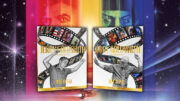
Books , Feature Films (TMP-NEM) , Music
Read: Exclusive Excerpt From ‘The Jerry Goldsmith Companion’ On Scoring ‘Star Trek: The Motion Picture’
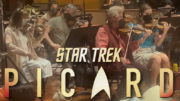
Music , Star Trek: Picard
See ‘Star Trek: Picard’ Season 3 Orchestra Pay Homage To Jerry Goldsmith, With Score From New Composer

Awards , Celebrity , Feature Films (TMP-NEM) , Music , Trek on TV

Jerry Goldsmith Finally Gets Star On Hollywood Walk of Fame For Star Trek and Other Work
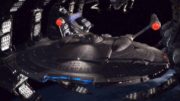
ENT , Interview , Music , Review , Soundtrack
REVIEW – Star Trek: Enterprise Collection, Volume 2
ooooohhhhh I really like this but, I the original is better suited.
That font! 🥰
Over a long period of time I’ve learnt to appreciate TMP a lot more. It still not one of my absolute favourites but the score most certainly is. I will go out on a limb here and say it’s still the finest Star Trek score of all time. It’s pretty magical. Jerry Goldsmith you still very much missed.
The blaster beam has such a distinctive sound- really sets TMP score apart from the other films.
I bought one, and purchased the big CD release back when it was new. Great companion/set.
The score is all at concert pitch, so if you want to plunk out the parts at your piano, you don’t have to transpose. This also makes it easier to see doublings, etc. As usual, viola parts are in alto clef.
I’ve not seen a film score before, so maybe rendering everything at concert pitch is standard in that industry? (Not so with other music… I’m mostly a choral conductor and composer but have conducted instrumental ensembles a bit, too.)
It depends on the composer. Most of the “old guard” asked their orchestrators to use transposed pitch; ST:TMP (Arthur Morton) was all done transposed. All of John Williams’ orchestrations are transposed. James Horner had his orchestrators use concert pitch (like Prokofiev). I am told that nowadays, concert pitch is much more common for today’s composers who are less likely to be classically trained.
Thanks for the info. Neat to be on this topic with Trek fans… my worlds of interest converge!
Thanks Lukas.
Well this is a super painful story. This is like showing us the ingredients of a cake and we have no access to getting the ingredients or putting it together.
I’m assuming most fans won’t even be able to read the recipes (to stay with your analogy), let alone recreate them. This kind of book probably has a very small target audience.
This reminds me that Star Trek is famous for introducing god-like or very very powerful beings, and then having absolutely zero follow-up. The Organians, Metrons… and THIS–a follow-up somewhere along the way would have been welcome. In fact, the only follow-through we’ve ever had with a god-like being has been Q. And even then, he’s still quite a mystery.
Beautiful music. Amazing how those themes imprint on your memory.
Compilation Albums

Theme from "Star Trek"
Added by Mop66 Managed by Clee J
- Highlights 3
- Versions 69
- Web Covers 2

First release by Leonard Nimoy (April 1967)
Theme from "Star Trek" written by Alexander Courage , Gene Roddenberry instrumental
Theme from "Star Trek" written by Alexander Courage , Gene Roddenberry English

by 331Erock

by Tenacious D
- Cast & crew
- User reviews

Star Trek: The Motion Picture
- When an alien spacecraft of enormous power is spotted approaching Earth, Admiral James T. Kirk resumes command of the overhauled USS Enterprise in order to intercept it.
- A massive alien spacecraft of enormous power destroys three powerful Klingon cruisers as it makes its way towards Federation space. Admiral James T. Kirk is ordered to take command of the USS Enterprise for the first time since her historic five-year mission. The Epsilon IX space station alerts the Federation, but they are also destroyed by the alien spacecraft. The only starship in range is the Enterprise, after undergoing a major overhaul in drydock orbiting Earth. Kirk rounds up the rest of his crew, and acquires some new members, and sets off to intercept the alien spacecraft. However, it has been three years since Kirk last went into deep space--is he up to the task of saving Earth? — Colin Tinto <[email protected]>
- The dazzling, refurbished USS Enterprise soars proudly once again in this ultimate space adventure. When a massive alien spacecraft destroys three powerful Klingon cruisers, Captain James T. Kirk returns to the newly-transformed USS Enterprise to take command. William Shatner is joined by Leonard Nimoy , DeForest Kelley , and the cast from the acclaimed "Star Trek" television series. The alien spacecraft of enormous power enters Federation space and neutralizes everything in its path. The entire crew mobilizes at warp speed to stop the alien intruder from its relentless flight toward Earth. — Robert Lynch <[email protected]>
- In 2273, a Starfleet monitoring station, Epsilon Nine, detects an alien force, hidden in a massive cloud of energy, moving through space towards Earth. The cloud destroys three of the Klingon Empire's new K'I'Inga-class warships and the monitoring station on route. On Earth, the star ship Enterprise is undergoing a major refit; her former commanding officer, James T. Kirk (William Shatner), has been promoted to Admiral and works in San Francisco as Chief of Starfleet Operations. Starfleet dispatches Enterprise to investigate the cloud entity as the ship is the only one in intercept range, requiring her new systems to be tested in transit. Kirk takes command of the ship citing his experience, angering Captain Willard Decker (Stephen Collins), who had been overseeing the refit as its new commanding officer. Testing of Enterprise's new systems goes poorly; two officers, including the science officer, are killed by a malfunctioning transporter, and improperly calibrated engines almost destroy the ship. Kirk's unfamiliarity with the new systems of the Enterprise increases the tension between him and first officer Decker. Commander Spock (Leonard Nimoy) arrives as a replacement science officer, explaining that while on his home world undergoing a ritual to purge all emotion, he felt a consciousness that he believes emanates from the cloud. Other officers are Leonard McCoy (DeForest Kelley), the chief medical officer. Montgomery Scott (James Doohan), the Enterprise's chief engineer. Pavel Chekov (Walter Koenig), the Enterprise's weapons officer. Uhura (Nichelle Nichols), the communications officer. Hikaru Sulu (George Takei), the Enterprise's helmsman Enterprise intercepts the energy cloud and is attacked by an alien vessel within. But this time, Spock is able to discern that the alien vessel has been trying to communicate with the Enterprise. Spock fixes the Linguacode and transmission frequencies of their reception and the attacks on the Enterprise stop. A probe appears on the bridge, attacks Spock and abducts the navigator, Ilia (Persis Khambatta). She is replaced by a robotic replica, another probe sent by "V'Ger" to study the crew. Decker is distraught over the loss of Ilia, with whom he had a romantic history. He becomes troubled as he attempts to extract information from the doppelganger, which has Ilia's memories and feelings buried within. Spock takes a spacewalk to the alien vessel's interior and attempts a telepathic mind meld with it. In doing so, he learns that the vessel is V'Ger itself, a living machine. Shortly thereafter V'Ger transmit a signal in simple binary code on radio and asks for the creator. When it receives no response, it fires probes into the atmosphere that Enterprise calculates will rid the planet of mankind. Ilia the robot tells Kirk that V'Ger has calculated that the Carbon lifeforms infest the creator's planet as it infests the Enterprise and hence needs to be eliminated to stop interfering with the creator's work. Spock suggests that V'Ger is a child and asks Kirk to treat it as such. Kirk tells Ilia the robot why the creator has not responded but won't reveal that to V'Ger. V'Ger has a huge power surge (in the manner of throwing a tantrum). Kirk holds and says to Ilia robot that he will only reveal the information to V'Ger directly. As such, the Enterprise is pulled towards the V'Ger's central brain complex. At the center of the massive ship, V'Ger is revealed to be Voyager 6, a 20th-century Earth space probe believed lost. The damaged probe was found by an alien race of living machines that interpreted its programming as instructions to learn all that can be learned and return that information to its creator. The machines upgraded the probe to fulfill its mission, and on its journey the probe gathered so much knowledge that it achieved consciousness. Spock realizes that V'Ger lacks the ability to give itself a focus other than its original mission; having learned what it could on its journey home, it finds its existence empty and without purpose. Before transmitting all its information, V'Ger insists that the Creator come in person to finish the sequence. Realizing that the machine wants to merge with its creator, Decker offers himself to V'Ger; he merges with the Ilia probe and V'Ger, creating a new form of life that disappears into another dimension. With Earth saved, Kirk directs Enterprise out to space for future missions.
Contribute to this page

- See more gaps
- Learn more about contributing
More from this title
More to explore.

Recently viewed
LCARS Theme Gallery
There are 8 themes currently available:
1 • Classic Theme
Although not the first LCARS display seen on screen, I still refer to this style and color palette as 'classic' because it was often visible in all three Star Trek series: The Next Generation, Deep Space Nine and Voyager. It is also my original LCARS inspired web design and is the theme for this website.

2 • Nemesis Blue Theme
Inspired by the various LCARS displays as seen in the Next Generation movie Star Trek: Nemesis.

3 • Picard Theme
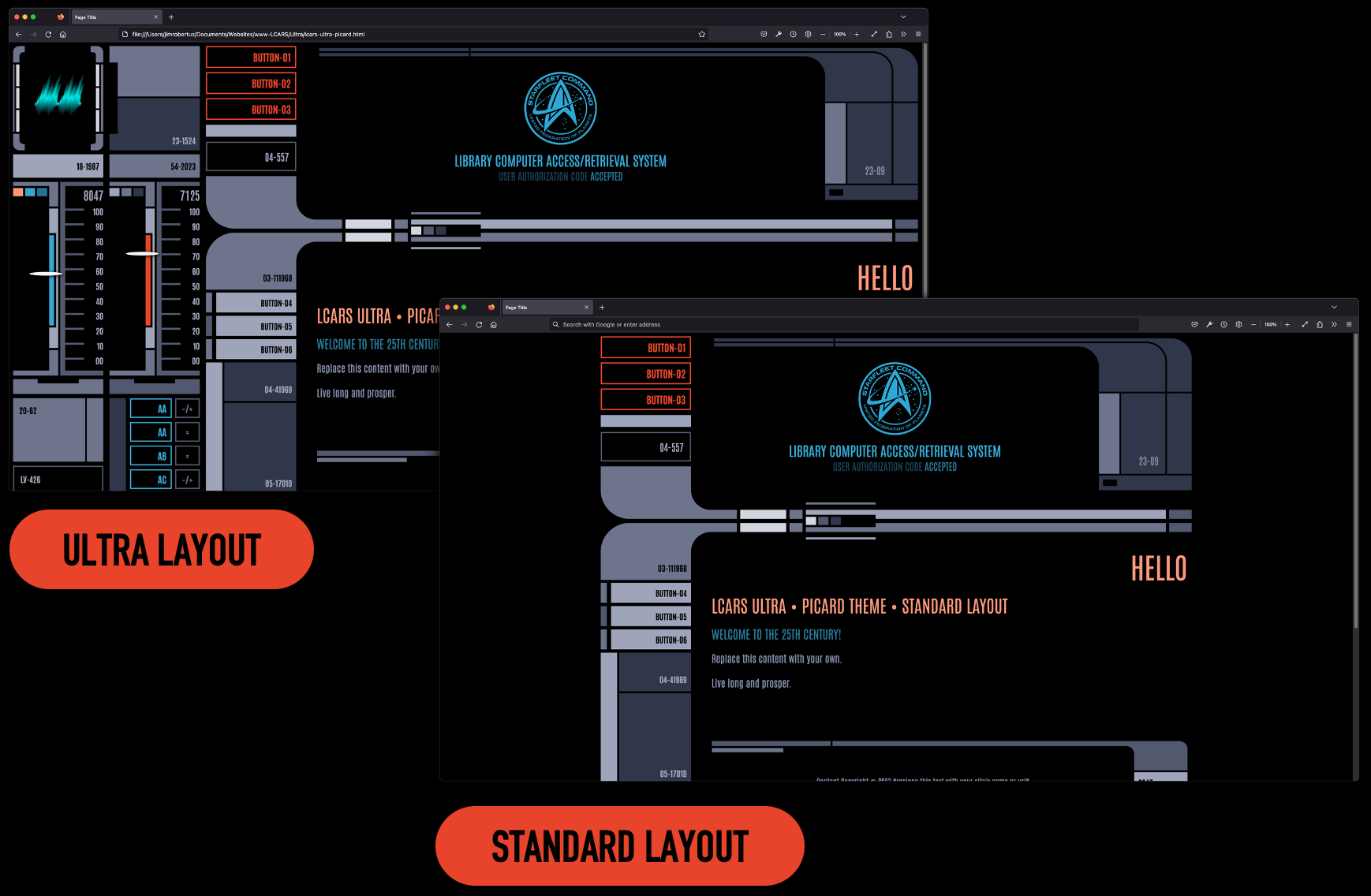
4 • Lower Decks Theme
Inspired by the animated series Star Trek: Lower Decks.

5 • Lower Decks PADD Theme
Inspired by the LCARS seen on PADDs in the animated series Star Trek: Lower Decks.

6 • TNG Legacy Theme
Inspired by LCARS as seen on the first season of Star Trek: The Next Generation.

7 • TNG Legacy 2 Theme
A variation of the TNG Legacy theme as seen in later seasons of Star Trek: The Next Generation.

8 • Red Alert Theme
NOTE: This theme is in line to be converted to the Ultra platform.
- Share full article

‘Star Trek’ Fan Leaves Behind a Collection Like No One Has Done Before
When Troy Nelson died, his shelves were filled to the rafters with memorabilia from the popular franchise. Soon, the massive collection will be boldly going, going, gone.
Evan Browne said her brother Troy’s love of “Star Trek” began with the original series, which he and his siblings watched at dinnertime. Credit... Connie Aramaki for The New York Times
Supported by

By Sopan Deb
- Published April 1, 2024 Updated April 3, 2024
Editors’ Note, April 2, 2024: After publication, The Times learned that Troy and Andrew Nelson were named in a civil lawsuit filed in Pierce County Superior Court in 1998, in which they were accused of molesting three disabled adults in a state-licensed facility that they operated. After a six-week jury trial, Washington State was ordered to pay $17.8 million to the plaintiffs. The state said it intended to appeal but missed the deadline and paid the victims. The Nelson brothers denied the allegations and were never criminally charged.
Troy Nelson and his younger brother Andrew were almost inseparable.
The two youngest of six, they were born two years apart. They lived together in their childhood home in Bremerton, Wash., for more than half a century. Near their home, there is a park bench on which they carved their initials as young boys.
The Nelson brothers never married or had children. They worked together at the same senior home. They even once, as teenagers, dated the same girl at the same time while working different shifts at the same pizza shop. This lasted a week until they realized it.
“Two parts of one body,” Evan Browne, their older sister, said of their relationship in an interview.
On Feb. 28, Andrew Nelson, who had been treated for cancer for years, went to feed the chickens and ducks that were gifts from Ms. Browne to her brothers. He had a heart attack and died. He was 55. Just hours later, Troy Nelson, who was stricken with grief, took his own life. He was 57.
“He had talked about it before,” Browne, 66, said, tearfully. “He said, ‘Hey, if Andrew goes, I’m out of here. I’m checking out.’ Andrew would say the same thing, and then it really happened .”

What Troy Nelson left behind has become a sensation. After his death, family members posted pictures on social media of his massive — and, really, the keyword is massive — collection of “Star Trek” memorabilia, which have now been shared thousands of times.
The items took up two living rooms and a bedroom, all lined with bookshelves, according to Elena Hamel, one of the brothers’ nieces. The centers of the rooms were lined with additional bookshelves — all packed to the brim — to create aisles. There were jewelry cabinets serving as display cases.
The shelves contained action figures. Dolls. Models of ships. Posters. Ornaments. Lunchboxes. Legos. Several toy phasers and tricorders. (For non-Trek fans, the phaser is a weapon, and a tricorder is, essentially, a fancy smartphone.) Multiple “Star Trek” lamps. (Yes, there are “Star Trek” lamps.) Trading cards. Comic books. Trek-themed Geeki Tikis (stylized tiki mugs). Life-size cutouts of famous characters. A life-size captain’s chair.
While it’s impossible to account for every private collector in the world, Troy Nelson’s collection is almost assuredly among the largest — if not the largest.
The last additions to the collection came in the final weeks of his life: Stuffed rabbits in “Star Trek” uniforms. “I’ve never seen a collection that size,” said Russ Haslage, the president of the International Federation of Trekkers , a “Star Trek”-themed nonprofit that Haslage founded with Gene Roddenberry, the creator of the franchise.
Haslage’s organization opened in 2020 a “Star Trek” museum in Sandusky, Ohio, that has received donations of memorabilia from estates. Those collections “pale in comparison” to Mr. Nelson’s, he said. (Haslage has reached out to the family to ask about donations from the collection.)
The older brother’s love of “Star Trek” began with the original series, which he’d watch with his siblings.
“It was our dinner meal,” Ms. Browne said. “When we had dinner, we were sitting in front of ‘Star Trek.’”
Troy Nelson began collecting in the late-1970s. His first acquisition was a model version of the Starship Enterprise. Then came Star Trek conventions. Why the franchise was such a draw to him remains a mystery to his family.
“I really can’t say. I mean, other than the fact that he was brainwashed with it at dinner time,” Browne said, laughing. “That sounds ridiculous. When we grew up, it’s like, ‘Dinner is at this time. And if you don’t get here at this time, you don’t get dinner.’ So it might’ve been a comfort for him .”
Troy Nelson would often monitor sites like eBay for items he didn’t have. On several occasions, he would express frustration on losing out on an item before being able to bid on it. Until he found out the reason.
“Andrew already got it for him,” Ms. Browne recalled.
Obsessive “Star Trek” fandom has long become an indelible part of pop culture, especially as the franchise — which has spawned several television series, movies, novels and comics — has been a long-running institution. There have been documentaries that have studied the subject, such as “Trekkies” in 1997. It’s been lampooned on “The Simpsons,” “Saturday Night Live” and “Family Guy,” and become a story line in an episode of “The West Wing,” among many others. For dedicated fans, accruing collectibles isn’t uncommon.
“When you collect these things, you’re closer to that genre that you enjoy so much,” Haslage said. “When I first started in 1979, I was grabbing everything I could get my hands on because it was cool, and it was a piece of the whole ‘Star Trek’ mythos. If you have these pieces, you’re a part of that universe in some way.”
It turns out that collecting is a pursuit that runs in the family.
Andrew Nelson collected mall swords, Ryobi-branded tools and statues of warrior women, like Xena, the warrior princess .
Browne’s house has a wall with thousands of smashed pennies and her living room windows are full of glass sugar and creamer bowls.
Browne’s father, Bud Peers, collected salt and pepper shakers, guns and knives. Troy and Andrew’s father, Norman Nelson, collected scrap metal and wood.
Hamel has 17 Christmas trees, all fully decorated with separate themes.
Browne’s son, Michael, who is 36, collects anything and everything related to black bears.
“ When you have a large collection like that and it’s displayed like that,” Hamel said, “and it’s something that is important to you, it’s often really calming to be in a space like that. It’s just all the things that you love. It’s soothing.”
As far as Browne knew, Troy had no history of mental illness or any previous suicide attempts. After Andrew died, she received a distraught and frantic call from Troy with the news. She told him that she was on her way.
Ms. Browne said she called him when she got to the Tacoma Bridge. No answer. And then again, at the Manette Bridge. No answer. When she reached their home, the back door was open. And then she found him. The phone call was the last time they spoke.
Troy Nelson did not leave a note, but did leave some things meticulously arranged by his computer, including a key to the house, burial plans for the two brothers, and bills.
“ I don’t know really what I thought,” Ms. Browne said. “All I could do was just scream.”
The Nelson family is boxing up Troy’s “Star Trek” collection to prepare it for auction. Andrew’s ashes will be placed in an urn carved in the likeness of the supermodel Bettie Page . (He was a fan.) Troy’s ashes will be placed in a “Star Trek” lunchbox.
If you are having thoughts of suicide, call or text 988 to reach the 988 Suicide and Crisis Lifeline or go to SpeakingOfSuicide.com/resources for a list of additional resources.
Sopan Deb is a Times reporter covering breaking news and culture. More about Sopan Deb
Advertisement

Dune Part Two: Similar Sci-Fi Franchises
- Complex political intrigue of Dune is mirrored in The Expanse , creating a tense atmosphere fans will enjoy despite scale differences.
- Star Wars' themes of destiny and power echo Dune's , with both featuring protagonists facing temptation and world-changing potential.
- The Faded Sun Trilogy offers a unique take on desert-dwelling warriors akin to Dune's Fremen, adding an alien perspective to similar themes.
Although Frank Herbert's Dune (1965) was once considered to be unfilmable, the recent success of Denis Villeneuve's take on the material has shown that this is far from true. Thanks to breathtaking visuals and strong performances by actors like Zendaya and Timothee Chalamet, the epic tale of Paul Atreides' revenge against the scheming Harkonnens has impressed fans and critics alike.
6 Things Dune Part Two Does Better Than Part One
The Dune movies may be long (clocking in at a combined 320 minutes), but they've left many fans hungry for more. Luckily, many much-loved elements of Hebert's narrative can be found in a number of acclaimed movies, books, and television shows. From classic franchises like Star Wars to lesser-known novels, there are plenty of options for fans looking to spice up their wait for Villeneuve's next movie.
Movies (1979–2019) | Created by George Lucas
- First Movie: Star Wars Episode 4: A New Hope (1977)
- Latest Movie: Star Wars Eipsode 9: The Rise of Skywalker
- Other Media: Books, Video Games, TV Series, Animation, Comics
A young man with a close association to a desert planet is destined to play a vital role in overthrowing the galactic government, but may discover that power has a tendency to corrupt. If this premise sounds familiar, it's because it broadly sums up the character arcs of both Dune 's Paul Atreides and Star Wars ' Anakin Skywalker. In another universe, it might also have described Luke Skywalker—George Lucas even toyed with the idea of having Luke take his father's place as the franchise big-bad following Vader's defeat.
Outside the prequel movies, Star Wars lacks the political maneuvering central to Dune 's narrative, preferring to focus on a simpler good versus evil narrative. However, there are similarities to Herbert's space opera, with Jedi mind tricks coming across as a twist on the Bene Gesserit's Voice.
The Expanse
Television series (2015–2022) | created by mark fergus and hawk ostby.
- Premiere Date: December 14, 2015
- Total Seasons: 6
- Cast: Steven Strait, Thomas Jane, Dominique Tipper, Wes Chatham
- Based On: The Expanse novels by James S. A. Corey
While The Expanse (based on a series of novels by James S.A. Corey) lacks the desert imagery of Dune , it more than makes up for this by replicating Herbert's fiendishly complex web of political machinations. Devious political operators like Chrisjen Avasarala could even give the Harkonnens a run for their money, while the mysterious protomolecule has all the universe-changing potential of Arrakis' spice.
Dune: The Politics Of The Imperium, Explained
Admittedly, early seasons of The Expanse primarily focus on the political situation within the Solar System rather than reaching for Dune 's epic scale, but this does nothing to detract from the show's tense atmosphere. The Expanse may be different to Dune in terms of how it depicts the future, but its dense world-building and strong characters are sure to draw in fans of Herbert's work.
Star Trek: Deep Space Nine
Television series (1993–1999) | created by rick berman and michael piller.
- Premiere Date: January 3, 1993
- Total Seasons: 7
- Cast: Avery Brooks, Rene Auberjonois, Colm Meaney, Cirroc Lofton
- Based On: Star Trek created by Gene Roddenberry
Star Trek creator Gene Roddenberry famously disliked the idea of religion in his utopian future, but Deep Space Nine demonstrated that storylines which explored faith could make for gripping and thought-provoking television. Much like Paul Atreides, DS9 's Benjamin Sisko finds himself adopted as a religious figure, the Emissary of the Prophets, by a group of alien worshipers. Like Paul, Sisko is reluctant to accept this role, which will lead to him playing a dramatic role in galactic events.
Due to DS9 's ensemble cast and broad range of topics, Sisko's path towards godhood is far less central to the narrative than Paul's journey in Dune . However, the Star Trek series nonetheless manages to emulate the political backstabbing, epic warfare, and arc of an outsider being adopted into an alien culture that is central to Herbert's novels.
Novel (1968) | Written by Samuel R. Delaney
- Publication Date: 1968
- Publisher: Doubleday
Written when Delaney was just 25 years old, Nova imagines a future in which a resource vital for space travel, Illyrion, sparks a feud between rival human factions. The powerful Red family is desperate to maintain its hold over the flow of Ilyrion, while the upstart Lorq Von Ray aims to find a fresh supply of the power source at the center of an exploding star. The parallels to Dune 's conflicts over spice production are evident.
Dune: 6 Book Characters Missing From The New Movies
Nova also bears tonal similarities to Dune . Despite the book's futuristic setting, Delaney emphasizes elements of the historical and occult, such as the focus on great houses and the use of tarot cards in place of some technologies. Given Delaney's inventiveness, it's surprising that Nova has yet to be adapted for the screen, although a Neil Gaiman-led adaptation was announced in 2023.
Television Series (1993–1998) | Created by J. Michael Stracyznski
- Premiere Date: January 26, 1994
- Total Seasons: 5
- Cast: Mira Furlan, Bruce Boxleitner, Richard Briggs, Michael O'Hare
- Other Media: Novels, Comics, Short Stories, Animation
Denis Villeneuve's Dune movies have been rightly praised for their impressive visuals, so it might seem odd to compare them to Babylon 5 , a series which has not aged well in the looks department. However, despite some wonky early CGI and a tight budget, Babylon 5 remains one of the foundational texts of small-screen science fiction.
J. Michael Stracynzi's series features several Dune -adjacent elements, including an unforgettable portrayal of how power corrupts and some doom-laden prophecies. Babylon 5 is less tightly focused than Herbert's novels, as it covers a wide range of alien races in addition to conflicts between different human factions. The result is a living, breathing universe that rivals the journey of Paul Atreides in the script department, even if it can't compete in purely visual terms.
The Faded Sun Trilogy
Novels (1978–1979) | written by c.j. cherryh.
- Publication Date: 1978
- Publisher: DAW Books
The Faded Sun Trilogy comprises part of Cherryh's epic Alliance–Union Universe, a series spanning thousands of years and dozens of novels. Set following humanity's victory over the alien regul and their mri mercenaries, the trilogy focuses on the budding relationship between the human Sten Duncan and the mri Niun. The mri are a race of desert-dwelling warriors, much like the Fremen , and Duncan must learn their ways if he is to survive various challenges and betrayals.
While the first book in the trilogy, Kesrith , is particularly reminiscent of Dune due to its desert-planet setting, the later novels ( Shon'jir and Kutath ) also invite comparisons. The corpulent, scheming regul are not unlike Dune's Baron Harkonnen, although Cherryh's talent for creating truly alien cultures ensures that The Faded Sun novels never feel derivative. Indeed, Cherryh's foregrounding of mri characters offers an extraterrestrial perspective on human affairs that is absent from Herbert's saga.
Dune: Every Novel Written By Frank Herbert, Introduced

By providing your information, you agree to our Terms of Use and our Privacy Policy . We use vendors that may also process your information to help provide our services. This site is protected by reCAPTCHA Enterprise and the Google Privacy Policy and Terms of Service apply.
The ‘X-Men ’97’ Smartly Repurposes Iconic Theme Song for Its Experimental Score
Bill desowitz.
- Share on Facebook
- Share to Flipboard
- Share on LinkedIn
- Show more sharing options
- Submit to Reddit
- Post to Tumblr
- Print This Page
- Share on WhatsApp
All hell broke loose in the fifth episode of “X-Men ’97,” “Remember It.” The shocking events are so traumatic, in fact, that fired showrunner Beau DeMayo momentarily broke his silence about the show to explain why it was important to reflect that “the X-Men have now been hit hard by the realities of an adult and unsafe world.”
“We started tackling the music in a sort of multi-faceted way at first [before seeing full episodes] because we didn’t really want to pretend that we knew exactly what the show should be because there are so many aspects,” Grush told IndieWire. “So, for us, it was about trying to give proper credit to various genres and ideas, and seeing how those felt to the team and letting that sort of evolve throughout the season. Related Stories Conan O’Brien Mocks Warner Bros. Discovery’s Max Rebranding: ‘They Used to Call It HBO, but That Was Too Popular’ ‘Franklin’ Isn’t Very Good. What It Represents Is Worse.

But because the series continues to escalate its powder keg of hate and destruction, the composers couldn’t find the usual thematic consistency of other shows. “Oftentimes in a TV series, there will be a comfort level at a certain point,” Grush added. “Like, these are the sounds we’re using, and we’ll use this theme for this character, and let’s just perform it differently. That’s out the window with this show.”
Thus, the duo was forced to step it up musically using different sounds. “You’re never really sure what’s going to happen with the story,” Stewart told IndieWire. “You could be in a really intense moment and then you’re in a loving moment, and then something else crazy happens. So we had to honor that musically.”
Fortunately, they were able to find comfort and inspiration in the iconic theme song from Haim Saban and Shuki Levy, developing and weaving it throughout the series. “That was our temperature gauge and keeping it more to the original was very intended,” Grush added. “If it had been wildly different, way more modern, I don’t think it would have worked the same.”
A perfect example was the counterpoint in a triplet section with piano that they ended up having to mute. “But then we were able to use that counterpoint at the end [of the cue],” Stewart continued. “But we had to lose the tubular bells because there were some modern synths that were taking up a lot of sonic space.”
They would also sprinkle the main theme with orchestra or synths to hint at when the team was forming or coming together for a fight as an ebb and flow. The first episode of “X-Men ’97” was necessarily filled with nostalgia, but, as the series progressed, they got to tease some different percussive sounds and introduce new thematic material.
“We were able to use the new escalation of danger to our advantage because that gives a pulse to the story that we then don’t have to worry about creating,” Stewart said. One example was Episode 3’s (“Fire Made Flesh”) “Inferno”-like vision of Hell from Sinister (Christopher Britton) and Jean Grey’s Clone, Madelyne Pryor (both voiced by Jennifer Hale), which got the Gothic treatment with organ, synths, closed mic orchestra, and choir.
Most Popular
You may also like.


IMAGES
VIDEO
COMMENTS
Soundtrack from the 1979 Robert Wise film "Star Trek: The Motion Picture" with William Shatner, Leonard Nimoy, Deforest Kelly, James Doohan, Walter Koenig, N...
The music to the 1979 American science fiction film Star Trek: The Motion Picture featured musical score composed by Jerry Goldsmith,: 87 beginning his long association with the Star Trek film and television. Influenced by the romantic, sweeping music of Star Wars by John Williams, Goldsmith created a similar score, with extreme cutting-edge technologies being used for recording and creating ...
"Star Trek was an attempt to say that humanity will reach maturity and wisdom on the day that it begins not just to tolerate, but take a special delight in d...
The " Theme from Star Trek " (originally scored under the title "Where No Man Has Gone Before") [1] is an instrumental musical piece composed by Alexander Courage for Star Trek, the science fiction television series created by Gene Roddenberry that originally aired between September 8, 1966, and June 3, 1969.
The Original Series Star Trek: The Motion Picture (1979). The score for Star Trek: The Motion Picture was written by Jerry Goldsmith, who would later compose the scores Star Trek V: The Final Frontier, Star Trek: First Contact, Star Trek: Insurrection, and Star Trek: Nemesis, as well as the themes to the television series Star Trek: The Next Generation and Star Trek: Voyager.
This is the actual first studio recording of the Main Title theme for Star Trek: The Motion Picture on October 23, 1979. Goldsmith can be heard giving correc...
"I was miserable," admitted Jerry Goldsmith. Four months from the December 7, 1979 release date of Star Trek: The Motion Picture, the composer only had a limited amount of footage and had to begin recording in a month.It was hardly an ideal situation, and it would get worse before it got better, but Goldsmith's score would go on to become an iconic part of Gene Roddenberry's creation.
The Star Trek: The Motion Picture soundtrack was the commercial release of Jerry Goldsmith's score for Star Trek: The Motion Picture. Originally released in 1979 by Columbia Records in LP and cassette formats, it was later released on CD in 1986. The first and one of the most influential Star Trek film scores, Jerry Goldsmith's introduction to the Star Trek universe is by many considered to be ...
Star Trek: The Motion Picture [Music from the Original Soundtrack] by Jerry Goldsmith released in 1979. Find album reviews, track lists, credits, awards and mor. ... Moods and Themes. Our Properties. AllMusic. AllMovie. SideReel. Site Overview. New Releases. Discover. Articles. Recommendations.
Epic science-fiction stories, with their cosmic themes and fast truths about the nature of mankind, somehow work best when the actors are unknown to us. The presence of the Star Trek characters and actors who have become so familiar to us on television tends in a strange way to undermine this movie. The audience walks in with a possessive, even patronizing attitude toward Kirk and Spock and ...
Jerry Goldsmith's score to Star Trek: The Motion Picture became the signature piece of Star Trek film music, with a main theme repurposed for Star Trek: The Next Generation (at Gene Roddenberry ...
1979 Cover themes by Bob James Other information: Members who have this label in their: Collection: 0 Wish list: 0. Things you can do: Update this label Enter a track listing ... Main Theme from "Star Trek - The Motion Picture" (03:16) 2. Ilia's Theme (Love Theme from "Star Trek - The Motion Picture") (03:01) Total Duration: 00:06:17 Track ...
Star Trek: The Motion Picture is a 1979 American science fiction film directed by Robert Wise and based on the television series Star Trek created by Gene Roddenberry, who also served as its producer.It is the first installment in the Star Trek film series, and stars the cast of the original television series.In the film, set in the 2270s, a mysterious and immensely powerful alien cloud known ...
Perhaps the most obvious example of this is his iconic title music for Star Trek: The Motion Picture (1979) that was subsequently adopted as the theme tune for Star Trek: The Next Generation. His work was held in such high regard, when Star Trek V: The Final Frontier (1989) ran into production issues, it was thought that a Jerry Goldsmith ...
Provided to YouTube by Symphonic DistributionStar Trek The Motion Picture (1979) - Main Theme · Geek Music · Geek MusicThe Star Trek Collection℗ 2018 Geek Mu...
The song Theme from "Star Trek" was written by Alexander Courage and Gene Roddenberry and was first released by Leonard Nimoy in 1967. It was covered by m.a.s.s., ... 1979: i: TV Themes: Star Trek - Happy Days: Phil Kelsall: 1979: Medley: i: Star Trek: Neil Norman and His Cosmic Orchestra: 1979: Unverified: i: Theme from "Star Trek" Meco: 1980: i:
Synopsis. In 2273, a Starfleet monitoring station, Epsilon Nine, detects an alien force, hidden in a massive cloud of energy, moving through space towards Earth. The cloud destroys three of the Klingon Empire's new K'I'Inga-class warships and the monitoring station on route. On Earth, the star ship Enterprise is undergoing a major refit; her ...
1979: Main Theme From Star Trek - The Motion Picture (7", 45 RPM, Single, Stereo)CBS, Tappan Zee Records: CBS 8128, 8128Netherlands: 1979: New Submission. Main Theme From Star Trek - The Motion Picture (7")CBS, Tappan Zee Records: SCBS 8128: UK: 1979: Recommendations. Purple Rain. Prince And The Revolution. Released. 1984 — US.
1 • Classic Theme. Although not the first LCARS display seen on screen, I still refer to this style and color palette as 'classic' because it was often visible in all three Star Trek series: The Next Generation, Deep Space Nine and Voyager. It is also my original LCARS inspired web design and is the theme for this website.
This is simply the Star Trek main theme. This is different from any other of the Star Trek scores because this is the only score that doesn't feature the ori...
Well-made film is ruined by stupid dialog and embarrassing logic, and seems less like a space adventure and more like a naval adventure. Wrath of Khan embraced the high seas sailor/pirate undertones of Star Trek, but this movie just makes space travel dumb. All that's left is a lot of pretty effects, which still hold up.
"When I first started in 1979, I was grabbing everything I could get my hands on because it was cool, and it was a piece of the whole 'Star Trek' mythos. If you have these pieces, you're a ...
Jerry Goldsmith. Jerrald King Goldsmith (February 10, 1929 - July 21, 2004) was an American composer known for his work in film and television scoring. He composed scores for five films in the Star Trek franchise and three in the Rambo franchise, as well as for films including Logan's Run, Planet of the Apes, Tora!
Complex political intrigue of Dune is mirrored in The Expanse, creating a tense atmosphere fans will enjoy despite scale differences.; Star Wars' themes of destiny and power echo Dune's, with both ...
Check out our epic cover of the theme from Star Trek: The Original Series. About time we gave Star Trek some loving. Enjoy!🔔Follow us🔔 ☞https://smarturl.it...
The Newton Brothers found comfort and inspiration in the iconic theme song when writing the music for the unpredictable 'X-Men 97' animated series. ... 'Star Trek: Strange New Worlds' Hasn't ...